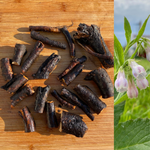Subscribe and save 10%!

Comfrey 'Bocking 14' 3pcs Root Cuttings (Symphytum x uplandicum)
132 SEK
Unit price perExpected delivery date: 18 December to 25 December.
Applies to orders within Sweden. For other countries - see our delivery terms .
In stock - Ready to be shipped
Share
132 SEK
Unit price per3pcs Root Cuttings in different lengths and thickness, around 2-5cm - derived from perennial mother plant of the variety 'Bocking 14' (naturally propagated via roots)
Comfrey root cuttings usually establish easily.
Place the root cuttings in soil and cover with a 1-2 cm layer of soil. Works
well to put both in pot and outdoors. Make sure to keep the soil moist. Preferably place the root cuttings in partial shade until their first above-ground shoots emerge, after that you can move the Comfrey out to its permanent growing location, which has no major requirements. It can take up to 2 months for root cuttings to set their first shoots. If you are growing your plants indoors or in a greenhouse, it's significantly faster.
'Bocking 14' is a sterile variety which means it lacks the ability to
produce and spread through seed. Propagation occurs only underground. This results in 'Bocking 14' together with 'Bocking 4' and others not being classified as invasive.
The plant is sent safely and securely with shock-absorbing packaging.
Common name: Comfrey, Boneset, Knitbone, Consound, Slippery Root
Scientific name: Symphytum x uplandicum
Family: Boraginaceae
Plant history & use:
Comfrey is historically a well-used plant in the treatment of various ailments. But above all, it is a very effective accumulator of nutrients, i.e. a good soil improver. Comfrey grows quickly and the roots are deep, which gives the plant access to nutrients from deeper soil layers that are otherwise inaccessible to most plants. It is mostly minerals such as potassium and calcium that are stored in the leaves, but also magnesium, iron, phosphorus, manganese and more.
The leaves from the comfrey plant can be cut down during the year and used as cover material, or alternatively buried in the soil, to make the nutrients available to other plants. Comfrey leaves are well suited as a fertilizer for fruit trees and berry bushes thanks to their potassium and phosphorus content.
Comfrey has a long growing season, early winter to late autumn.
If the leaves are not cut before winter, they wither and in the same way add nutrients to the soil they grow on. New leaves begin to emerge on the plant shortly after the snow melts.
You can make your own fertilizer tea from comfrey by filling a container with the leaves and then filling with water up to the edge. Leave for a couple of days and then mix the fertilizer tea with 10 parts water to irrigate the plants with.
Comfrey is effective as an edging plant near manure piles to prevent nutrient leakage, but also as an edging plant around plantations and other places where you don't want root weeds to spread. Comfrey's dense root system forms an underground wall, making it difficult for other roots to get through.
Comfrey creates an overall attractive environment for other plants in your cultivation - through attracting pollinators, serving as a natural fertilizer, and more.
Cultivation:
Comfrey is a herbaceous perennial native to Europe. It continues to grow on the site the next year even after the leaves have withered during the winter.
It is an incredibly easy-to-grow plant and it is tolerant in the choice of plant location. It can grow in shade as well as wet soils and is therefore an effective component in flooded and waterlogged soils.
It also thrives in drier soils in sunny locations, although it does best in a slightly moist environment.
Characteristics:
Lifespan: Perennial
Location: Shade/Semi-shade/Sun
Height: 50-180 cm
USDA Zone: 3-10
- Choosing a selection results in a full page refresh.
- Opens in a new window.







